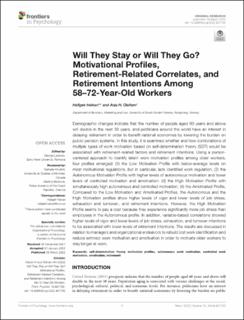| dc.contributor.author | Halvari, Halgeir | |
| dc.contributor.author | Olafsen, Anja Hagen | |
| dc.date.accessioned | 2023-02-07T08:37:17Z | |
| dc.date.available | 2023-02-07T08:37:17Z | |
| dc.date.created | 2022-05-30T13:58:55Z | |
| dc.date.issued | 2022 | |
| dc.identifier.citation | Halvari, H. & Olafsen, A. H. (2022). Will They Stay or Will They Go? Motivational Profiles, Retirement-Related Correlates, and Retirement Intentions Among 58–72-Year-Old Workers. Frontiers in Psychology, 13, Artikkel 807752. | en_US |
| dc.identifier.issn | 1664-1078 | |
| dc.identifier.uri | https://hdl.handle.net/11250/3048742 | |
| dc.description.abstract | Demographic changes indicate that the number of people aged 60 years and above will double in the next 30 years, and politicians around the world have an interest in delaying retirement in order to benefit national economies by lowering the burden on public pension systems. In this study, it is examined whether and how combinations of multiple types of work motivation based on self-determination theory (SDT) would be associated with retirement-related factors and retirement intentions. Using a person-centered approach to identify latent work motivation profiles among older workers, four profiles emerged: (1) the Low Motivation Profile with below-average levels on most motivational regulations, but in particular, lack identified work regulation; (2) the Autonomous Motivation Profile with higher levels of autonomous motivation and lower levels of controlled motivation and amotivation; (3) the High Motivation Profile with simultaneously high autonomous and controlled motivation; (4) the Amotivated Profile. Compared to the Low Motivation and Amotivated Profiles, the Autonomous and the High Motivation profiles show higher levels of vigor and lower levels of job stress, exhaustion and turnover-, and retirement intentions. However, the High Motivation Profile seems to pay a cost because they experience significantly more job stress than employees in the Autonomous profile. In addition, variable-based correlations showed higher levels of vigor and lower levels of job stress, exhaustion, and turnover intentions to be associated with lower levels of retirement intentions. The results are discussed in relation to managers and organizational endeavors to rebuild lost work identification and reduce extrinsic work motivation and amotivation in order to motivate older workers to stay longer at work. | en_US |
| dc.language.iso | eng | en_US |
| dc.rights | Navngivelse 4.0 Internasjonal | * |
| dc.rights.uri | http://creativecommons.org/licenses/by/4.0/deed.no | * |
| dc.title | Will They Stay or Will They Go? Motivational Profiles, Retirement-Related Correlates, and Retirement Intentions Among 58–72-Year-Old Workers | en_US |
| dc.type | Peer reviewed | en_US |
| dc.type | Journal article | en_US |
| dc.description.version | publishedVersion | en_US |
| dc.rights.holder | © 2022 Halvari and Olafsen. | en_US |
| dc.source.pagenumber | 11 | en_US |
| dc.source.volume | 13 | en_US |
| dc.source.journal | Frontiers in Psychology | en_US |
| dc.identifier.doi | https://doi.org/10.3389/fpsyg.2022.807752 | |
| dc.identifier.cristin | 2028147 | |
| dc.source.articlenumber | 807752 | en_US |
| cristin.ispublished | true | |
| cristin.fulltext | original | |
| cristin.qualitycode | 1 | |

